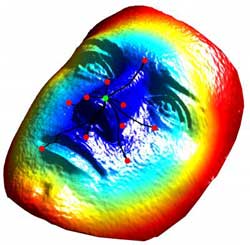Improving security with face recognition technology

This photo shows how to determine discriminative anatomical point pairings using Adaboost for 3-D face recognition. Credit: University of Miami<br>
A number of U.S. states now use facial recognition technology when issuing drivers licenses. Similar methods are also used to grant access to buildings and to verify the identities of international travelers. Historically, obtaining accurate results with this type of technology has been a time intensive activity. Now, a researcher from the University of Miami College of Engineering and his collaborators have developed ways to make the technology more efficient while improving accuracy.
Mohamed Abdel-Mottaleb, professor and chair in the UM Department of Electrical and Computer Engineering has developed state-of-the-art systems capable of photographing an image of someone's face and ear and comparing it against pre-stored images of the same person, with 95-100 percent accuracy.
Abdel-Mottaleb presented his findings at the 2009 IEEE International Conference on Image Processing in Cairo, Egypt on Saturday, November 7 – Tuesday, November 10. He describes his research as “satisfying, especially when you know that what you're doing has real-world applications that will benefit people and enhance personal security.”
The systems the researchers have designed can use 3-D facial images, or combine 2-D images of the face with 3-D models of the ear, which they construct from a sequence of video frames, to identify people by unique facial features and ear shapes.
In the first method, the researchers use 3-D facial images with over 95 percent recognition rate, in the lab setting. Conventional shape matching methods commonly used in 3-D face recognition are time consuming. Abdel-Mottaleb uses a method that effectively increases computational efficiency while maintaining an acceptable recognition rate. He reduces the number of vertices (distinguishable landmarks of each face) considered when matching 3-D facial data, by automatically selecting the most discriminative facial regions. These automatically selected landmarks were found to be primarily within the regions of the nose, eye brows, mouth, and chin.
The second method called “Multi-Modal Ear and Face Modeling and Recognition” obtains a set of facial landmarks from frontal facial images and combines this data with a 3-D ear recognition component– a much more difficult identification process given the technique's sensitivity to lighting conditions.
Fusing the scores of these two modalities, the researchers achieved an identification rate of 100 percent in the lab. “No single approach can give you 100 percent accuracy,” Abdel-Mottaleb says. “One way to increase the accuracy is to use different biometrics and then combine them.”
These high-tech identification tools help fight crime, and enforce border security. In the future, the researchers hope to expand their techniques to faces demonstrating facial expressions and to recognize faces using only profile images.
The University of Miami's mission is to educate and nurture students, to create knowledge, and to provide service to our community and beyond. Committed to excellence and proud of the diversity of our University family, we strive to develop future leaders of our nation and the world. www.miami.edu
Media Contact
More Information:
http://www.umiami.eduAll latest news from the category: Information Technology
Here you can find a summary of innovations in the fields of information and data processing and up-to-date developments on IT equipment and hardware.
This area covers topics such as IT services, IT architectures, IT management and telecommunications.
Newest articles

Machine learning algorithm reveals long-theorized glass phase in crystal
Scientists have found evidence of an elusive, glassy phase of matter that emerges when a crystal’s perfect internal pattern is disrupted. X-ray technology and machine learning converge to shed light…

Mapping plant functional diversity from space
HKU ecologists revolutionize ecosystem monitoring with novel field-satellite integration. An international team of researchers, led by Professor Jin WU from the School of Biological Sciences at The University of Hong…

Inverters with constant full load capability
…enable an increase in the performance of electric drives. Overheating components significantly limit the performance of drivetrains in electric vehicles. Inverters in particular are subject to a high thermal load,…





















